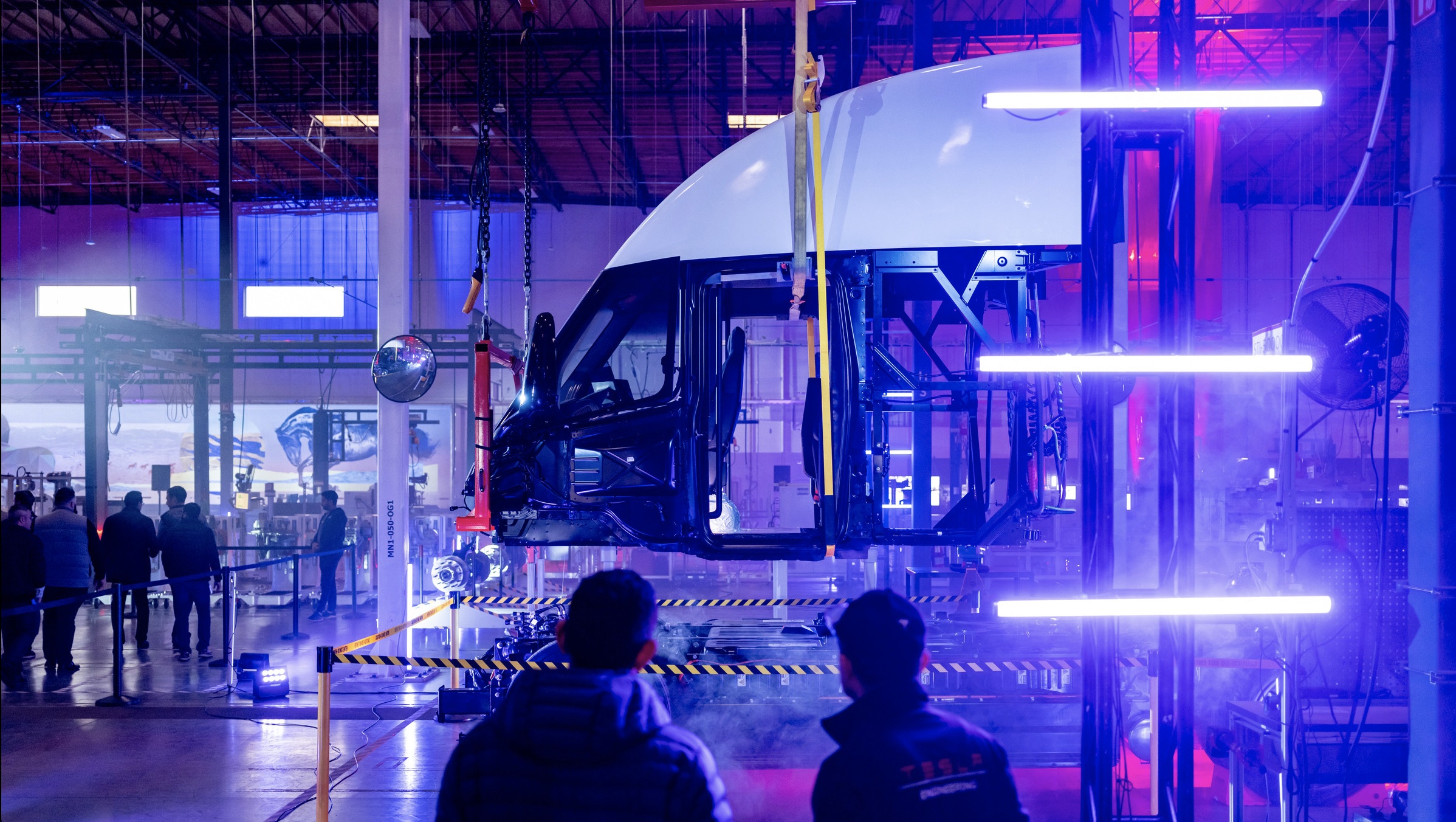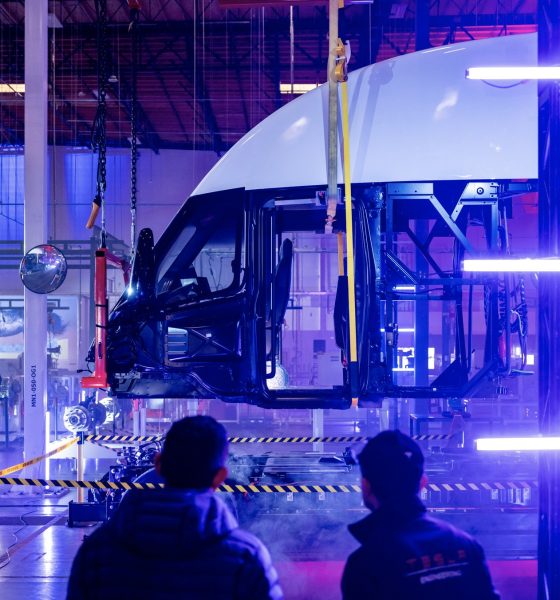Tesla submitted some proposals for Canada’s 2023 Federal Budget that may lay the foundation for the arrival of the Semi in Canada. Tesla’s proposals were submitted as part of Canada’s pre-budget consultations before the government’s 2023 budget is finalized.
Tesla sent its proposals in a letter addressed to Chrystia Freeland, Canada’s Deputy Prime Minister and Minister of Finance. The letter provides information on areas Tesla believes the Canadian government needs to focus on to accelerate the transition to EVs and sustainable energy.
Most of the proposals focus on Canada’s need to invest in an EV infrastructure. Interestingly enough, a whole section is dedicated to the electrification of medium and heavy-duty transportation, which the Tesla Semi would fall under.
Charging Infrastructure for Medium to Heavy-Duty EVs
“Tesla applauds the launch of the federal government’s iMHZEV Program as sales incentives should generate demand for MHDZEVs across the country. However, to sustainably support increased demand for electrified medium and heavy-duty transportation fleets, adequate charging infrastructure must be available to support short and long-haul transportation routes from coast to coast,” the EV company stated in the letter.
Tesla reasons that federal support could incentivize private-sector investment in MHDZEV charging along key transportation routes. The company suggests that Canada’s federal government identify which routes should receive incentives while the transition to zero-emission trucks is just beginning. Tesla states that the federal government must support the charging infrastructure needed “to scale electrification of the good[s] movement sector.”
Tesla also proposed that the government provide grants to freight haulers to support the power upgrades businesses would need to transition to electric heavy-duty trucks.
“We propose a program that would directly support all freight haulers of all sizes — not just the largest or smallest fleet operators. It is important to note that power upgrades must be made well in advance of companies taking delivery of electric trucks,” wrote Tesla.
“Charging facilities must be in place when the trucks arrive so that they can enter service immediately. [The] Government should consider providing funding to any company that can demonstrate it has placed electric truck orders — rather than deliveries.”
Tesla Semi Ramp
Tesla officially delivered its first Semi on December 1. The company held a small event for Semi deliveries at Giga Nevada. Tesla aims to produce up to 50,000 Semi trucks per year by 2024 in North America.
Some Tesla Semi trucks will be heading to Canada. Mosaic Forest Management — based in Vancouver Island — ordered three Tesla Semi trucks for logging activities. The Tesla Semis would be part of a pilot program to test the performance of electric heavy-duty trucks in the log hauling sector. If the Semi performs well in the pilot program, Mosaic plans to electrify its fleet of 300 trucks.
Mosaic is just one of many companies in Canada interested in electric heavy-duty trucks. The main concern with switching to electric trucks would be charging, so Tesla’s proposals are right on point.
The Tesla Semi already has some competition in the electric heavy-duty truck market. For instance, Daimler started deliveries of its Freightliner eCascadia last month.
However, The Tesla Semi does have an edge in charging. Tesla developed an innovative charging cable for the Semi, and it is also familiar with ramping EV charging infrastructure thanks to the Supercharger Network. Its range of 500 miles per charge is also superior to its rivals in the all-electric Class 8 segment.
Read Tesla’s full letter to Minister Chrystia Freeland below!
Tesla lays foundation for S… by Maria Merano
I’d like to hear from you. Contact me at maria@teslarati.com or via Twitter @Writer_01001101.

Elon Musk
Starlink passes 9 million active customers just weeks after hitting 8 million
The milestone highlights the accelerating growth of Starlink, which has now been adding over 20,000 new users per day.

SpaceX’s Starlink satellite internet service has continued its rapid global expansion, surpassing 9 million active customers just weeks after crossing the 8 million mark.
The milestone highlights the accelerating growth of Starlink, which has now been adding over 20,000 new users per day.
9 million customers
In a post on X, SpaceX stated that Starlink now serves over 9 million active users across 155 countries, territories, and markets. The company reached 8 million customers in early November, meaning it added roughly 1 million subscribers in under seven weeks, or about 21,275 new users on average per day.
“Starlink is connecting more than 9M active customers with high-speed internet across 155 countries, territories, and many other markets,” Starlink wrote in a post on its official X account. SpaceX President Gwynne Shotwell also celebrated the milestone on X. “A huge thank you to all of our customers and congrats to the Starlink team for such an incredible product,” she wrote.
That growth rate reflects both rising demand for broadband in underserved regions and Starlink’s expanding satellite constellation, which now includes more than 9,000 low-Earth-orbit satellites designed to deliver high-speed, low-latency internet worldwide.
Starlink’s momentum
Starlink’s momentum has been building up. SpaceX reported 4.6 million Starlink customers in December 2024, followed by 7 million by August 2025, and 8 million customers in November. Independent data also suggests Starlink usage is rising sharply, with Cloudflare reporting that global web traffic from Starlink users more than doubled in 2025, as noted in an Insider report.
Starlink’s momentum is increasingly tied to SpaceX’s broader financial outlook. Elon Musk has said the satellite network is “by far” the company’s largest revenue driver, and reports suggest SpaceX may be positioning itself for an initial public offering as soon as next year, with valuations estimated as high as $1.5 trillion. Musk has also suggested in the past that Starlink could have its own IPO in the future.
News
NVIDIA Director of Robotics: Tesla FSD v14 is the first AI to pass the “Physical Turing Test”
After testing FSD v14, Fan stated that his experience with FSD felt magical at first, but it soon started to feel like a routine.

NVIDIA Director of Robotics Jim Fan has praised Tesla’s Full Self-Driving (Supervised) v14 as the first AI to pass what he described as a “Physical Turing Test.”
After testing FSD v14, Fan stated that his experience with FSD felt magical at first, but it soon started to feel like a routine. And just like smartphones today, removing it now would “actively hurt.”
Jim Fan’s hands-on FSD v14 impressions
Fan, a leading researcher in embodied AI who is currently solving Physical AI at NVIDIA and spearheading the company’s Project GR00T initiative, noted that he actually was late to the Tesla game. He was, however, one of the first to try out FSD v14.
“I was very late to own a Tesla but among the earliest to try out FSD v14. It’s perhaps the first time I experience an AI that passes the Physical Turing Test: after a long day at work, you press a button, lay back, and couldn’t tell if a neural net or a human drove you home,” Fan wrote in a post on X.
Fan added: “Despite knowing exactly how robot learning works, I still find it magical watching the steering wheel turn by itself. First it feels surreal, next it becomes routine. Then, like the smartphone, taking it away actively hurts. This is how humanity gets rewired and glued to god-like technologies.”
The Physical Turing Test
The original Turing Test was conceived by Alan Turing in 1950, and it was aimed at determining if a machine could exhibit behavior that is equivalent to or indistinguishable from a human. By focusing on text-based conversations, the original Turing Test set a high bar for natural language processing and machine learning.
This test has been passed by today’s large language models. However, the capability to converse in a humanlike manner is a completely different challenge from performing real-world problem-solving or physical interactions. Thus, Fan introduced the Physical Turing Test, which challenges AI systems to demonstrate intelligence through physical actions.
Based on Fan’s comments, Tesla has demonstrated these intelligent physical actions with FSD v14. Elon Musk agreed with the NVIDIA executive, stating in a post on X that with FSD v14, “you can sense the sentience maturing.” Musk also praised Tesla AI, calling it the best “real-world AI” today.
News
Tesla AI team burns the Christmas midnight oil by releasing FSD v14.2.2.1
The update was released just a day after FSD v14.2.2 started rolling out to customers.

Tesla is burning the midnight oil this Christmas, with the Tesla AI team quietly rolling out Full Self-Driving (Supervised) v14.2.2.1 just a day after FSD v14.2.2 started rolling out to customers.
Tesla owner shares insights on FSD v14.2.2.1
Longtime Tesla owner and FSD tester @BLKMDL3 shared some insights following several drives with FSD v14.2.2.1 in rainy Los Angeles conditions with standing water and faded lane lines. He reported zero steering hesitation or stutter, confident lane changes, and maneuvers executed with precision that evoked the performance of Tesla’s driverless Robotaxis in Austin.
Parking performance impressed, with most spots nailed perfectly, including tight, sharp turns, in single attempts without shaky steering. One minor offset happened only due to another vehicle that was parked over the line, which FSD accommodated by a few extra inches. In rain that typically erases road markings, FSD visualized lanes and turn lines better than humans, positioning itself flawlessly when entering new streets as well.
“Took it up a dark, wet, and twisty canyon road up and down the hill tonight and it went very well as to be expected. Stayed centered in the lane, kept speed well and gives a confidence inspiring steering feel where it handles these curvy roads better than the majority of human drivers,” the Tesla owner wrote in a post on X.
Tesla’s FSD v14.2.2 update
Just a day before FSD v14.2.2.1’s release, Tesla rolled out FSD v14.2.2, which was focused on smoother real-world performance, better obstacle awareness, and precise end-of-trip routing. According to the update’s release notes, FSD v14.2.2 upgrades the vision encoder neural network with higher resolution features, enhancing detection of emergency vehicles, road obstacles, and human gestures.
New Arrival Options also allowed users to select preferred drop-off styles, such as Parking Lot, Street, Driveway, Parking Garage, or Curbside, with the navigation pin automatically adjusting to the ideal spot. Other refinements include pulling over for emergency vehicles, real-time vision-based detours for blocked roads, improved gate and debris handling, and Speed Profiles for customized driving styles.










